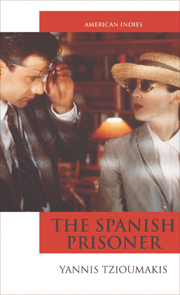Book contents
- Frontmatter
- Contents
- Series Preface
- Acknowledgements
- Dedication
- Introduction: ‘You don't know who anyone is’
- 1 From Independent to ‘Indie’ Cinema
- 2 David Mamet and ‘Indie’ Cinema
- 3 ‘Indie’ Film at Work: Producing and Distributing The Spanish Prisoner
- 4 ‘That's what you just think you saw!’ Narrative and Film Style in The Spanish Prisoner
- 5 Playing with Cinema: The Master of the Con Game Film
- Conclusion
- Filmography: David Mamet in American Cinema and Television
- Notes
- Bibliography
- Index
5 - Playing with Cinema: The Master of the Con Game Film
Published online by Cambridge University Press: 05 August 2013
- Frontmatter
- Contents
- Series Preface
- Acknowledgements
- Dedication
- Introduction: ‘You don't know who anyone is’
- 1 From Independent to ‘Indie’ Cinema
- 2 David Mamet and ‘Indie’ Cinema
- 3 ‘Indie’ Film at Work: Producing and Distributing The Spanish Prisoner
- 4 ‘That's what you just think you saw!’ Narrative and Film Style in The Spanish Prisoner
- 5 Playing with Cinema: The Master of the Con Game Film
- Conclusion
- Filmography: David Mamet in American Cinema and Television
- Notes
- Bibliography
- Index
Summary
A Mamet film requires faith: Things are rarely what they seem. His works are exercises in metamorphosis. Or in illusions. Take your pick.
Introduction
In her book Weasels and Wisemen: Ethics and Ethnicity in the Work of David Mamet, Leslie Kane argues that ‘game-playing as structure and element of plot is a controlling figure’ in both Mamet's films and his stage plays. Following Thomas M. Leitch, who studied the function of game-playing in the films of Alfred Hitchcock, Kane suggests that game-playing in Mamet's films ‘evokes complex concordances from which the audience derives pleasure “from having followed the director's lead”’. She continues:
Mamet's films, like Hitchcock's, ‘beguile audiences’ enticing them to follow the action as ‘a move in the game’ that surprises or disorients them, ‘encourag[ing] them to fall into misidentifications and misinterpretations which have specific moral or thematic force’.
Besides evoking what has once been called ‘the master image for genre criticism’, an image which in Tom Ryall's words consists of ‘a triangle composed of artist/film/audience’, the above approach to Mamet's films flirts with genre criticism in, at least, two additional ways. First, it groups a number of films on the basis of a ‘controlling’ common characteristic (in this case game-playing). Second, it raises the question of the spectators' systems of expectations in the viewing process and the way in which those systems are affected by the controlling characteristic of this group of films (spectators are encouraged to misidentify and misinterpret).
- Type
- Chapter
- Information
- The Spanish Prisoner , pp. 88 - 122Publisher: Edinburgh University PressPrint publication year: 2009



